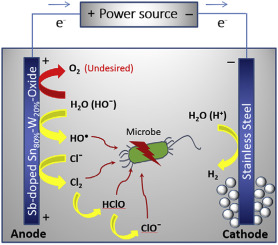当前位置:
X-MOL 学术
›
Water Res.
›
论文详情
Our official English website, www.x-mol.net, welcomes your feedback! (Note: you will need to create a separate account there.)
Electrochemical disinfection of bacteria-laden water using antimony-doped tin-tungsten-oxide electrodes
Water Research ( IF 12.8 ) Pub Date : 2017-09-18 , DOI: 10.1016/j.watres.2017.09.029 Saloumeh Ghasemian , Bahareh Asadishad , Sasha Omanovic , Nathalie Tufenkji
Water Research ( IF 12.8 ) Pub Date : 2017-09-18 , DOI: 10.1016/j.watres.2017.09.029 Saloumeh Ghasemian , Bahareh Asadishad , Sasha Omanovic , Nathalie Tufenkji

|
Electrochemical disinfection has been shown to be an efficient method with a short-required contact time for treatment of drinking water supplies, industrial raw water supplies, liquid foodstuffs, and wastewater effluents. In the present work, the electrochemical disinfection of saline water contaminated with bacteria was investigated in chloride-containing solutions using Sb-doped Sn80%-W20%-oxide anodes. The influence of current density, bacterial load, initial chloride concentration, solution pH, and the type of bacteria (E. coli D21, E. coli O157:H7, and E. faecalis) on disinfection efficacy was systematically examined. The impact of natural organic matter and a hydroxyl radical scavenger on the disinfection process was also examined. The electrochemical system was highly effective in bacterial inactivation for a 0.1 M NaCl solution contaminated with ∼107 CFU/mL bacteria by applying a current density ≥1 mA/cm2 100% inactivation of E. coli D21 was achieved with a contact time of less than 60 s and power consumption of 48 Wh/m3, by applying a current density of 6 mA/cm2 in a 0.1 M NaCl solution. Reactive chlorine species as well as reactive oxygen species (e.g. hydroxyl radicals) generated in situ during the electrochemical process were determined to be responsible for inactivation of bacteria.
中文翻译:

掺锑锡钨氧化物电极对含细菌水的电化学消毒
电化学消毒已被证明是一种有效的方法,其接触时间短,可用于处理饮用水,工业原水,液体食品和废水。在目前的工作中,使用掺Sb的Sn 80% -W 20%-氧化物阳极在含氯化物的溶液中研究了被细菌污染的盐水的电化学消毒。电流密度,细菌载量,初始氯化物浓度,溶液pH值和细菌类型(大肠杆菌D21,大肠杆菌O157:H7和粪肠球菌的影响))对消毒效果进行了系统检查。还检查了天然有机物和羟基自由基清除剂对消毒过程的影响。该电化学系统是用于污染〜10的0.1M NaCl溶液的细菌失活非常有效7 CFU / ml的细菌通过施加电流密度≥1毫安/厘米2的100%失活的大肠杆菌D21用的接触时间实现通过在0.1 M NaCl溶液中施加6 mA / cm 2的电流密度,可在不到60 s的时间内完成功耗为48 Wh / m 3的操作。原位产生的活性氯和活性氧(例如羟基) 在电化学过程中被确定是导致细菌失活的原因。
更新日期:2017-09-18
中文翻译:

掺锑锡钨氧化物电极对含细菌水的电化学消毒
电化学消毒已被证明是一种有效的方法,其接触时间短,可用于处理饮用水,工业原水,液体食品和废水。在目前的工作中,使用掺Sb的Sn 80% -W 20%-氧化物阳极在含氯化物的溶液中研究了被细菌污染的盐水的电化学消毒。电流密度,细菌载量,初始氯化物浓度,溶液pH值和细菌类型(大肠杆菌D21,大肠杆菌O157:H7和粪肠球菌的影响))对消毒效果进行了系统检查。还检查了天然有机物和羟基自由基清除剂对消毒过程的影响。该电化学系统是用于污染〜10的0.1M NaCl溶液的细菌失活非常有效7 CFU / ml的细菌通过施加电流密度≥1毫安/厘米2的100%失活的大肠杆菌D21用的接触时间实现通过在0.1 M NaCl溶液中施加6 mA / cm 2的电流密度,可在不到60 s的时间内完成功耗为48 Wh / m 3的操作。原位产生的活性氯和活性氧(例如羟基) 在电化学过程中被确定是导致细菌失活的原因。


























 京公网安备 11010802027423号
京公网安备 11010802027423号